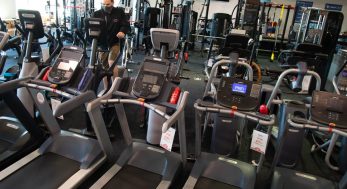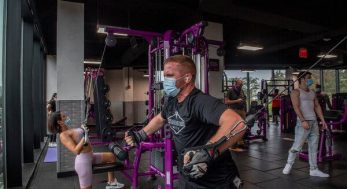Courtesy: Bob Prichard
The preponderance of modern swim training is improving fitness. Sure, there is a dollop on technique, but since the prevailing sentiment is that everyone has their own technique, why spend a lot of time on it?
Here is the idea. Swimming a ton of yardage will stimulate your heart to grow bigger (like any other muscle), it will squirt out more blood with each beat, that bigger squirt will carry more oxygen to your muscles, you won’t tire out so fast and you will swim faster. Along the way, your capillary bed with grow, improving the delivery of oxygen to your frazzled muscles.
It’s easy to measure your fitness. Just get a VO2max test. If you are really ‘fit’, you will be in the 70-90 category, or ‘world-class’.
Seems simple enough. After all, everyone has had the experience of falling behind on the last leg because they ‘ran out of gas’.
But is it that simple?
Let’s take Janet Evans as an example. Janet simultaneously held World Records in the 400, 800- and 1500-meter freestyle. Some of her records lasted 19 years. Janet must have been a VO2max beast.
Wrong.
Janet had a VO2max of only 56. How low is that? Well, a couch potato has a VO2max of 46. Her competitors were in the 70-80 group. In other words, Janet was closer to being a couch potato than a ‘world-class’ swimmer.
But she was world-class. In fact, she was the best for 18-19 years.
Was it her stroke? Was it much more efficient than anyone else’s?
It wasn’t. It was just ‘average’. She did have an unusual over the water recovery stroke, but underwater her stroke was average according to her hand force output curve.
So—what did coaches and swim scientists do? Did they put her under a microscope to see why she was so much faster than anyone else with such a low VO2max?
No. They just continued increasing yardage by distance or intensity. Oh yes. They also added in weightlifting.
But I have a habit of investigating highly successful athletes, so I flew down to Southern California where she was competing in a meet and asked her if I could measure her flexibility. It sounds unusual, but I have done this with dozens of elite athletes in many sports.
Janet had average flexibility in her legs, hips and shoulders. When I say average, I mean for elite swimmers.
But there were three areas where she had 50% more flexibility.
Her breathing ranges.
I measure breathing ranges in a three-step process that compensates for athlete size so I can compare a five-year-old age group swimmer with a 6’8” goliath.
First, I measure the circumference of the stomach (at the belly button), the diaphragm (the top of the costal arch) and the chest (nipple line for men, just below the breasts for women).
Then I have them blow out all their air, ask them to take a deep breath (expanding all three areas) and measure the amount of expansion. I then divide the amount of each expansion by its circumference to get their breathing range.
Janet’s breathing ranges were all 16%. This means that someone with a 36” chest expands 5.76”.
Her competition? The many I have measured were all 10-12%.
So, does this mean anything? It does. When I doubled the chest expansion of one of my athletes from 2” to 4”, his lung capacity increased 33%, from 3.22 liters to 4.3 liters.
Do you think you might be able to swim faster if your chest expanded 50-100% more than your competitors?
Another swimmer I measured did. He was a national record holder in the 100-meter freestyle. He had the biggest amount of expansion I have ever measured. His chest was 45” and expanded 9”, or 20%. I asked him if he ever got tired during a race. He looked puzzled. ‘Why would I get tired? It was only 100 meters’ was his response.
Age group swimmers in my swim camps have improved their times up to 18% after just one week of stroke improvement and chest expansion. The most surprising thing? Following up with their parents six months later I found that their grade point average had improved a full letter grade. One gal went from a C+ average to a B+ average, with an A- in physics!
Now, you are probably thinking that 20% chest expansion is something you are born with and have for the rest of your life.
Not true. 20% is something you are born with, but most people lose.
The kids entering my swim camps in 2000 all had less chest expansion than before. I had never seen an across-the-board drop like this in the 15 years I had been running these camps. As I was releasing the microfibers (mild scar tissue) that were restricting their chest expansion, they recalled the stress that tightened up their chests.
Their school backpack.
I was dumbfounded. How could a school backpack permanently reduce chest expansion and lung capacity? So, I did some research. First, I found out that larger and heavier backpacks became common in the mid-90’s as schools required more and more books and supplies be carried to school every day. Then I found 8 studies from around the world that measured a reduction in lung capacity when kids put on their school backpack. The reduction was measurable when the backpack weighed only 5% of body weight (no one carries a load that light) and climbed to a 40% reduction when the weight was increased. A survey by the US Department of Education found a 40% drop in freshmen STEM (Science, Technology, Engineering, Math) majors between 1996 and 2004. In 1996, college freshmen had been carrying bigger, heavier backpacks for 1 year. In 2004, they had been carrying them for 8 years.
Did these kids swim faster after we undid the damage from their backpacks? Of course they did. Did their grades improve? Yes, they did.
But there are other ways to lose your 20% expansion. Chronic colds and allergies, asthma, bronchitis, pneumonia—especially when you are young—can permanently cut chest expansion in half. Sports impacts like trapping a soccer ball with your chest, getting tackled or elbowed in the chest, falling on a football, a car accident or bike fall, texting, playing video games, vaping and emotional or mental stress. In reaction to all these stresses we tighten our muscles and the connective tissue (which is not very bright) thinks we have cracked a rib and so starts to create microfibers to immobilize the area so it can heal. The problem then is two-fold. First, the connective tissue never figured out how to release those microfibers. Second, they tend to accumulate over time, gradually reducing flexibility. Chest, diaphragm and stomach expansion are lost by the ordinary happenings of life.
Oh yes. There are some other ways swimmers lose their breathing ranges (this is not going to make a lot of coaches very happy). Bench presses, push-ups, pull-ups, swim benches, hand paddles, pull buoys, sit-ups and ‘core’ work are other stresses our swimmers have recalled as we have released microfibers around their chest and stomach. They then took deeper breaths and swam faster.
So—what does all this mean?
Should you measure your breathing ranges? Should your whole team measure their breathing ranges? Should you stop doing things that reduce chest expansion and lung capacity?
No. I wouldn’t bother. It will just confuse everyone. They already have so much on their plate anyway.
The best thing is just to keep doing what you have always been doing. Maybe increase your yardage or weights just a little bit. Don’t do anything too different. After all, everyone knows the formula for success. Why mess with it?
ABOUT BOB PRICHARD
Bob Prichard is President of Somax Performance Institute in Tiburon, CA. His 18 Olympic swimmers have won 43 Gold Medals and set 11 World Records. His age group and masters swimmers have won state, national and regional championships. A former columnist for the New York Times, he has worked as an analyst for NBC Sports Olympics and has been cited in Sports Illustrated and Sport magazine among many others.


